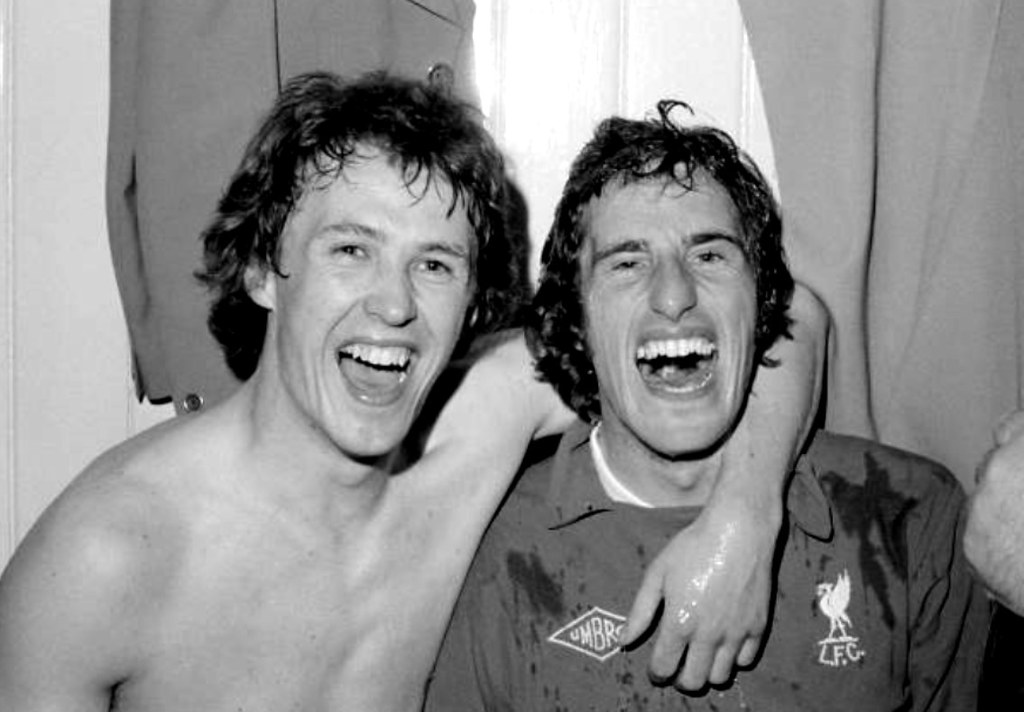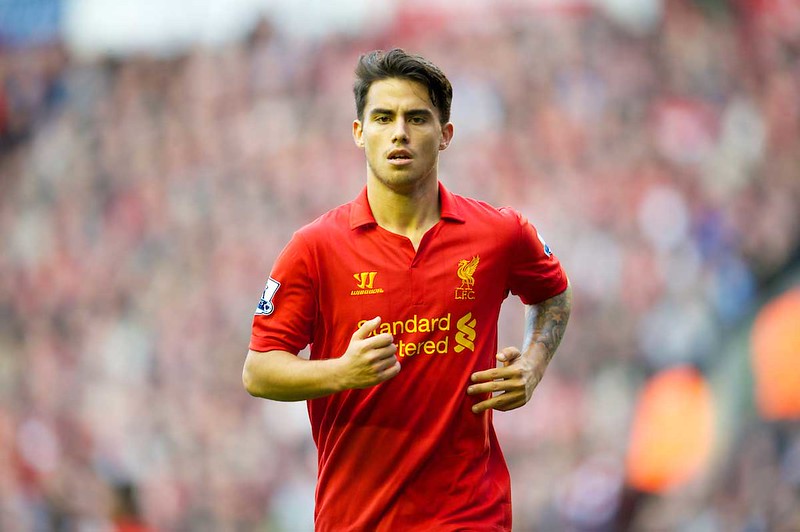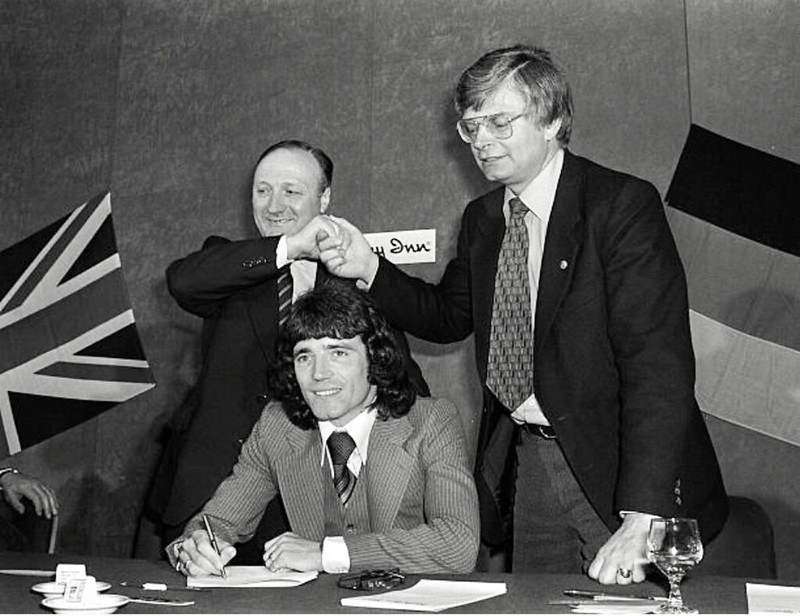Articles
Fishing for minnows
It’s that time of year again. Fans, some of whom seem to judge transfer prospects solely on the basis of what they’d seen on Match of the Day, offer their opinions as to who we should pay ridiculously small sums for in order to turn them into world-beaters. Some reporters trade in exciting, or alarming headlines, only to admit that their prospect for LFC is worse than unlikely. Sources close to the manager relay supposedly confidential information about a ‘target’, boosted by the alluring ‘Klopp likes him’ (or the indefinite ‘Klopp is known to like him’ or ‘Klopp is understood/believed to like him’.). Every top club in Europe appears to want to sign him, and even God is rumoured to be interested.

Phil Neal and Ray Clemence celebrating winning the league in 1980
What is the reality of a minnow being plucked from a lower league and finding stardom with LFC? How many have transferred at a young age and then (like Andre Wisdom, for example) waited years for a first team place, enjoying the kudos of what society at large places on football, but sometimes only to watch names, already famous, bought in order to occupy the position they had expected?
What follows is the result of Liverpool seeking out those who were recruited from leagues lower than the top tier in any country, and who subsequently earned a place in an LFC squad. The most recent acquisitions will therefore be somewhat underrepresented as they have not (yet) made it to the top.
Historians will not be surprised to learn that the picture changes over time. The stats below are from analysing 440 players recruited during the eight decades from 1953 to 2022/23, plus an initial look at earlier seasons since 1946. Their arrival has not been evenly spread. For example, the 1990s saw the acquisition of more new players than the most stable – and successful – seasons in the 1960s and 1970s added together; decades in the new century have recruited three times as many. Among these recruits, those from lower leagues have not followed the same pattern. Until 2011, the actual number recruited from lower leagues remained steady (on average, about one to one and a half each year), but doubled since, with Rodgers and Klopp clearly more willing than their predecessors to fish for minnows.
Home grown
What we are interested in are those who, whatever their nationality, have been snapped up from, say, the second, third or fourth tier of English football. Since the second world war, about one in four have satisfied that criterion, the other three quarters having been brought from First Division or Premiership clubs. (Only technically in this whole category, and therefore not included, are the players recruited ‘locally’ to Liverpool, some 94 in total, who may well have been taken into the Academy from minor non-league clubs near the city.) Anyone disparaging such a search for talent as beneath the dignity of Premiership royalty, but who like to indulge in that cul-de-sac game of creating a mythical team using real players, may like to use the following (all becoming internationals) who were recruited by LFC from clubs lower than the top tier in the British leagues. (The exercise is really to illustrate the quality which may be out there despite the perceived lower status of the sending club.)
Players lined up according to positions
| NAME | FROM | IN-TIER | YEAR |
| Adam Bogdan | Bolton | 2 | 2015 |
| Ray Clemence | Scunthorpe | 3 | 1967 |
| Brad Jones | Middlesbrough | 2 | 2010 |
| Danny Ward | Wrexham | 5 | 2012 |
| Joe Gomez | Charlton | 2 | 2015 |
| Stephane Henchoz | Blackburn | 3 | 1999 |
| Joey Jones | Wrexham | 3 | 1975 |
| Rob Jones |
Crewe | 4 | 1991 |
| Alec Lindsay | Bury | 3 | 1969 |
| Larry Lloyd | Bristol Rovers | 3 | 1969 |
| Phil Neal | Northampton | 4 | 1974 |
| Barry Venison | Sunderland | 2 | 1986 |
| Andre Wisdom | Bradford |
4 | 2008 |
| Mark Wright | Derby | 2 | 1991 |
| Charlie Adam | Blackpool | 2 | 2011 |
| Jimmy Case |
South Liverpool | 5 | 1973 |
| Peter Cormack | Nottingham Forest | 2 | 1972 |
| Don Hutchison | Hartlepool | 3 | 1990 |
| Jamie Redknapp | Bournemouth |
3 | 1991 |
| Danny Murphy | Crewe | 3 | 1997 |
| Kevin Sheedy | Hereford | 4 | 1978 |
| Jonjo Shelvey | Charlton | 3 | 2010 |
| Georginio Wijnaldum | Newcastle | 2 | 2016 |
| Alan A’Court | Prescot Cables | 5 | 1952 |
| Steve Heighway | Skelmersdale Utd | 5 | 1970 |
| Lee Jones | Wrexham | 4 | 1992 |
| Kevin Keegan | Scunthorpe | 4 | 1971 |
| Michael Robinson | Brighton | 2 | 1983 |
| Ian Rush | Chester | 3 | 1980 |
| Dean Saunders | Derby |
2 | 1991 |
| Xherdan Shaqiri | Stoke | 2 | 2018 |
| Raheem Sterling | QPR | 2 | 2010 |
| Albert Stubbins |
Newcastle | 2 | 1946 |
| Peter Thompson | Preston | 2 | 1963 |
| John Toshack | Cardiff | 2 | 1970 |
Foreign grown
Nowadays, shoals of minnows swim in geographically vast seas, but sought by world-wide fishing fleets, all competing to net a future star for Stamford Bridge, the San Siro, Nou Camp, or wherever.
From 1946 until Djimi Traore’s 1998 arrival from Laval in France, all our eight foreign lower league recruits had been found elsewhere in the British Isles, almost all of whom had played north of the border; since 1998, only Tony Gallagher (2019, from a yo-yo-ing Falkirk) has come from a Scottish lower division.

Suso failed to impress at Liverpool but has succeeded elsewhere
Those who have come to Anfield directly from a lower tier abroad, rather than via another English club, are very few indeed – perhaps 18 since the Second World War. In terms of their part on LFC’s history, Scottish international Steve Nicol is hard to beat. Recruited from second tier Ayr United in 1981, he waited only ten months to make his debut for LFC.
Pride of place in the list must also go to Suso, recruited from Cadiz, then in the second tier and about to be relegated. Some top Spanish clubs were interested, and it is said that, had it not been for Rafa Benitez, we would not have had him on LFC’s books. (No Spanish player had played for LFC before Rafa brought Josemi Ray in 2004/05.) I think we never fully used Suso’s abilities, and I regret seeing him now contributing to the Sevilla and Spanish national teams.
Few of the other foreign minnows will be remembered as fondly – Sander Westerveld, Djimi Traore himself, for example; Le Tallec from Le Havre was not used as frequently as his promising past suggested.
Conclusions
There are common elements running through many of the above examples of LFC recruitment, relating to the motives and standing of the selling clubs whose status is no longer quo. Vultures hover around clubs in financial difficulties – the sort of trouble which forced Feyenoord to sell fine players Dirk Kuyt to us and Salomon Kalou to Chelsea in 2006. A new manager sold almost the whole Shamrock Rovers squad, including Jim Beglin. Within a few months of LFC’s acquisition of Adam Bogdan, HMRC gave Bolton Wanderers a winding-up petition - but finding other examples from the lower leagues associated with LFC recruitment is very difficult.
Relegation is another problem which attracts clubs anxious to pick off players who are less than willing to share the misery of humiliation with their former colleagues. Within a year of their transfer, relegation affected the clubs of Michael Robinson (Brighton), Mark Wright (Derby), Rob Jones (Crewe), Sean Dundee (Karlsruher), David Martin (MK Dons), Miki Roque (Lleida) and Adam Bogdan (Bolton).
Harder to understand are the motives of some whose clubs are about to be, or have just been, promoted to a higher tier. The attraction of LFC alone was perhaps strong enough to attract Kevin Lewis (Sheffield U), Kevin Keegan (Scunthorpe), Peter McDonnell (Bury), Bob Bolder (Sheffield W), Don Hutchison (Hartlepool), Danny Murphy (Crewe), Raheem Sterling (QPR), and Sheyi Ojo (MK Dons).

Kevin Keegan was sold for a healthy profit to HSV (signing for them in this image) after six wonderful years at Liverpool.
Spotting players whose contracts are coming to an end is now commonplace, and again subject to speculation by the media unencumbered by the windows system. Whatever the quality of those listed above, they represent only a very small proportion of what might have been available, and at an economical price, over a sixty-year period – but extending the scouting network, especially in continents hardly touched so far, would have to be very cleverly planned.
Article by Dr. Colin Rogers for LFChistory.net

